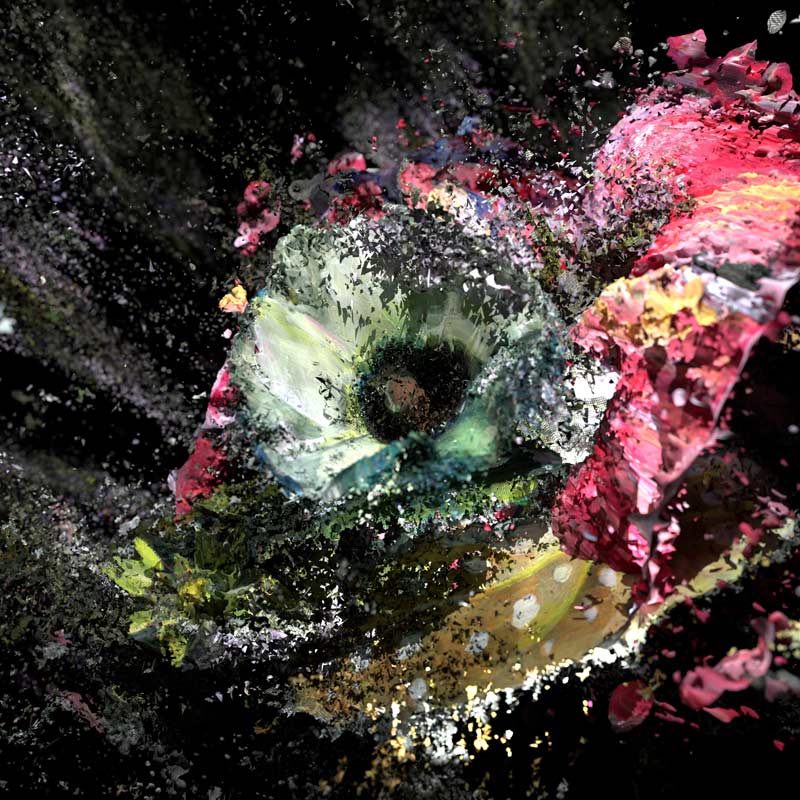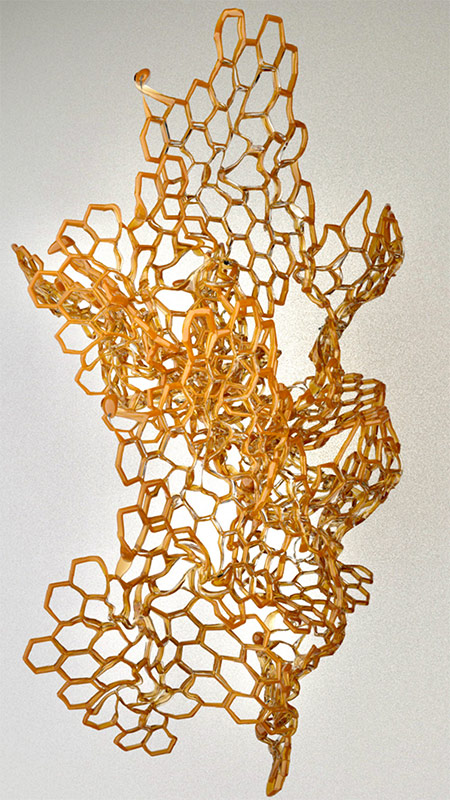22 INTERNATIONAL ARTISTS COME TOGETHER IN AN EXPLORATION OF MATERIALITY IN ART
For the 14th consecutive year, Maison Guerlain joins FIAC’s private itinerary with the new exhibition, “When Material Becomes Art”, running October 21 until November 14 2021, at 68 Avenue Des Champs-Élysées. This year, Guerlain, who since its founding has championed new forms of avant-garde expression and artistic innovation, invites the public to view an unprecedented new exhibition exploring materiality in art.
As artisans of the perceptible, the artists featured draw from their bodies to bring life and flesh to their emotions, ideas and commitments. Throughout the exhibition raw material as a medium in its natural, organic, mineral, artificial, industrial and even digital form is transformed, reimagined and enhanced to bring to life the palpable and lasting traces of each artist’s critical spirit and imagination.
From raw to virtual materials, the exhibition spans three levels of the Guerlain House bringing together sculptural works, paintings, photographs, installations and certified NFTs (Non Fungible Tokens) which have been specially produced for the occasion to showcase the potential of this creative territory.
n addition, the NFT-certified digital works presented throughout the exhibition will be sold in aid of the GoodPlanet Foundation, chaired by Yann Arthus-Bertrand.
ART AND MATERIAL, A SUBLIME OXYMORON
Art is the act of enhancing technique through love, said Nuno Oliveira! Beyond the artistic discipline itself, art therefore speaks to the senses and creates emotion. This is art’s purpose, it is what separates it from sheer function, it’s what creates its assertiveness that can’t be ignored!
One thing’s for sure, art is produced by will, it’s what makes humans quintessential. But “conceived of as power that doesn’t produce a re!ection” does art oppose nature?
With the exhibition “When Material Becomes Art”, Guerlain calls on the ways art and nature are allied. Here, the House reaf”rms the extent to which its own art, that of perfumery, relies on nature as a vital, yet fragile resource and ecosystem. For nearly two centuries Guerlain’s creative daring, unique expertise and unwavering commitment to the sublime quality of raw materials has been fuelled by its constant desire for innovation, while resolutely respecting balance and sustainability.
Thinking about art and natural material together means taking the era you live in by the hand and leading it towards the future.
Here, we “nd tangible works that draw us back to the concrete raw materials as well as an array of intangible, sometimes unfathomable digital works. Behind each creation the artists explore these questions, musing in each their own way and via their own intimate visions and beliefs.
To question materiality as an element in artistic creation is to question the world, our resources and the dangers we are confronted with. Art cannot be dissociated from the world that surrounds it. Not now, or ever.
The exhibition, «When Material Becomes Art» certainly poses more questions than it can answer. And this is its goal, to put into motion a truth that is conscious and respectful of its environment.
A combat that Guerlain is waging with strength and determination.
WHEN MATERIAL BECOMES ART
FOR ITS 14TH ANNUAL CONTEMPORARY ART EXHIBITION AT THE GUERLAIN HOUSE, “WHEN MATERIAL BECOMES ART” QUESTIONS THE TRANSFORMATION OF MATERIAL, HOW INSPIRATION IS TRANSFORMED AND HOW CREATIVE IDEAS ARE MADE MATERIAL.
Which comes first, the material or the art? It’s a question akin to the classic chicken and egg conundrum. Yet, this is the vast subject that we explore in this exhibition: Do you need material to make a work of art?
At risk of surprising you, the answer is no. You don’t need material to make art, or put differently, not every artist needs material (in its palpable sense) to create a work of art.
Does this mean that an artist’s creative idea can exist independently of their chosen medium?
This is truer for some than for others. In fact, recent art history is filled with examples of works that are part, or even entirely immaterial.
Since the second half of the 20th century artists have tended towards reducing material to its absolute minimum, going as far as to abandon it altogether. Among some of the most radical examples of this was Yves Klein, who from 1955 onwards, distilled his works into single monochrome canvases, and in 1958 mounted an exhibition on “the specialisation of sensibility in the raw material state into stabilized pictorial sensibility” at the entirely empty Iris Clert gallery.
Klein’s work found its counterparts across the Atlantic, where artists such as Bruce Nauman, Joseph Kosuth and Sol Lewitt looked at ways to reduce the visible parts of their work, favouring the idea behind the work itself (conceptual art) or even the idea that preceded it, and thereby pushing the actual performance of the piece to the background. More recently, this leads us to the work of Tino Sehgal, who markets his intangible work without leaving a trace.
In 2009, the Pompidou Centre hosted the exhibition “Vides” (Voids) in ten of the National Museum of Modern Arts’ rooms, where in an unprecedented way it brought together exhibitions that rigorously sought to show nothing and left the spaces empty of what they were designed for.
In parallel, with the birth of new technologies between 1980 and 1990, new “material” has left analogue material behind in favour of digital material.
With the emergence of this new genre of work, questions surrounding ownership have arisen. Until the early 2010s, digital “les could be endlessly duplicated so that their creators were rendered anonymous and sometimes even forgotten.
The arrival of the first NFTs – “non-fungible tokens” – is revolutionising the art world. This technology ensures the traceability and authenticity of digital files via individual secure codes. Blockchains – participatory, decentralized computer codes which allow transactions to be certified – introduce the concept of scarcity to digital art and in so doing enables it to have the same standing as analogue art. Artistic material has therefore become plural, at once tangible and intangible, and as dichotomous as our ever-changing, contemporary world.
So many major questions in the world are reflected through materials: from the climate crisis, with recycling and upcycling; the development of new cutting-edge technologies, with hybridisation; religion and beliefs with the use of religious symbols and articles of worship; and with the use of materials that have been historically attributed to one specific gender, globalisation and women’s place in society.
The focus of the exhibition “When Material Becomes Art” sits in stark contrast to current thinking on immateriality and revisits the notion of the artist as an alchemist. We think about material as more than a support and consider the creative act as being only made possible through being able to confront material. In short, the term “plastic artist” itself can be justified by this notion of plasticity through which everything is made malleable.
Beyond materiality, the question that interests us most is the transformative, creative act and artistic execution that it takes to create a piece of work. Throughout the exhibition, the artistic process is made visible so that once it is unmasked it becomes lived experience. Via subtle dissonances the eye becomes activated to question visual and artistic habits.
However, material alone isn’t enough. Only creative intervention can transform material into a surface upon which societal questions can be projected. And only then can it speak to a diverse array of subjects such as the climate crisis via upcycling; societal change via new technologies; a crisis in religion and belief via artists’ use of religious symbols and articles of worship; and the position of women in society.
Among the 22 artists presented within the exhibition, each artist’s approach is as diverse as their thought processes and individual achievements. The viewpoints adopted by the artists illustrate the concerns of our changing society and ask the same questions that are being posed by many great thinkers. After all, a real artist is essentially just a philosopher who sculpts their thoughts and ideas.
Ecological fragility is re!ected in the work of Favier and Cognée with their use of transformed, evolved living matter. For Cléron and Libertiny, it is the bee, the guarantor of our entire ecosystem – an idea which is particularly dear to Guerlain – who becomes the focus of their work. Another endangered species emerges in Sabatté’s uniquely alarming and fragile work. Armour, meanwhile, thinks about the similarities the materials in our body have with those in the mineral universe, and looks to high-tech alchemy in her work in much the same way as Bul does. Dakpogan becomes an archaeologist for society today, using dialogue between cultures as a theme. This also becomes the subject of Silva’s work, which re!ects on loss of knowledge and intergenerational ties. Russell takes on the art of conversion in the quest for beliefs and spiritual heritage. Ideas surrounding the quality of objects, artistic expertise and a frantic slowdown in consumerism are found in diverse and exciting works by Delvoye, El Zein and Carbonell. Finally, Muniz disrupts our many established visual habits, something which is essential for challenging us as viewers and increasing our ability to see. From conversion to mutation, adaptation to metamorphosis, throughout the exhibition themes of change come together in a world that stands on the threshold of a new era.


